
The 22nd United States Congress was a meeting of the legislative branch of the United States federal government, consisting of the United States Senate and the United States House of Representatives. It met in Washington, D.C. from March 4, 1831, to March 4, 1833, during the third and fourth years of Andrew Jackson's presidency. The apportionment of seats in the House of Representatives was based on the 1820 United States census. Both chambers had a Jacksonian majority.

The 23rd United States Congress was a meeting of the legislative branch of the United States federal government, consisting of the United States Senate and the United States House of Representatives. It met in Washington, D.C. from March 4, 1833, to March 4, 1835, during the fifth and sixth years of Andrew Jackson's presidency. The apportionment of seats in the House of Representatives was based on the 1830 United States census. The Senate had an Anti-Jacksonian or National Republican majority, and the House had a Jacksonian or Democratic majority.
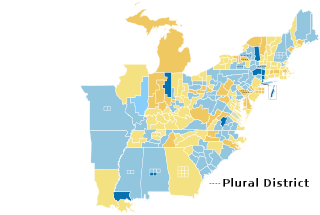
The 1840–41 United States House of Representatives elections were held on various dates in various states between July 6, 1840 and November 2, 1841. Each state set its own date for its elections to the House of Representatives, before or after the first session of the 27th United States Congress convened on May 31, 1841. Elections were held for all 242 seats, representing 26 states.
The 1838–39 United States House of Representatives elections were held on various dates in various states between July 2, 1838 and November 5, 1839. Each state set its own date for its elections to the House of Representatives before the first session of the 26th United States Congress convened on December 2, 1839. They occurred during President Martin Van Buren's term. Elections were held for all 242 seats, representing 26 states.

The 1834–35 United States House of Representatives elections were held on various dates in various states between July 7, 1834 and November 5, 1835. Each state set its own date for its elections to the House of Representatives before the first session of the 24th United States Congress convened on December 7, 1835. They were held during President Andrew Jackson's second term. Elections were held for 240 seats that represented 24 states, as well as the at-large-district seat for the pending new state of Michigan.
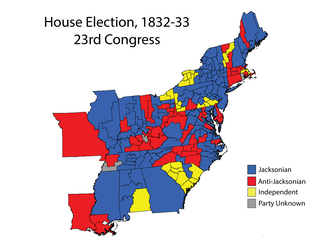
The 1832–33 United States House of Representatives elections were held on various dates in various states between July 2, 1832 and October 7, 1833. Each state set its own date for its elections to the House of Representatives before the first session of the 23rd United States Congress convened on December 2, 1833. They were held concurrently with the 1832 presidential election, in which Democrat Andrew Jackson was re-elected. The congressional reapportionment based on the 1830 United States Census increased the size of the House to 240 seats.

The 1812–13 United States House of Representatives elections were held on various dates in various states between August 3, 1812 and April 30, 1813. Each state set its own date for its elections to the House of Representatives before the first session of the 13th United States Congress convened on May 24, 1813. They coincided with James Madison being re-elected president.

The 1808–09 United States House of Representatives elections were held on various dates in various states between April 26, 1808 and May 5, 1809. Each state set its own date for its elections to the House of Representatives before the first session of the 11th United States Congress convened on May 22, 1809. They coincided with James Madison being elected as president. Elections were held for all 142 seats, representing 17 states.
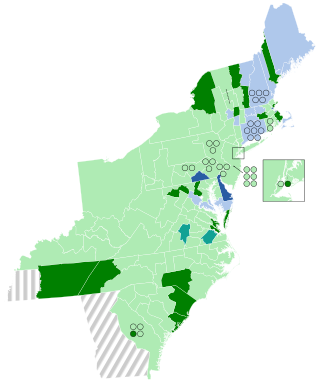
The 1804–05 United States House of Representatives elections were held on various dates in various states between April 24, 1804 and August 5, 1805. Each state set its own date for its elections to the House of Representatives before the first session of the 9th United States Congress convened on December 2, 1805. The elections occurred at the same time as President Thomas Jefferson's re-election. Elections were held for all 142 seats, representing 17 states.

The 1802–03 United States House of Representatives elections were held on various dates in various states between April 26, 1802 and December 14, 1803. Each state set its own date for its elections to the House of Representatives, either before or after the first session of the 8th United States Congress convened on October 17, 1803. They occurred during President Thomas Jefferson's first term in office.
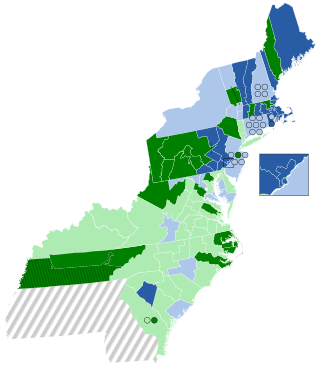
The 1794–95 United States House of Representatives elections were held on various dates in various states between August 25, 1794, and September 5, 1795 (Kentucky). Each state set its own date for its elections to the House of Representatives before the first session of the 4th United States Congress convened on December 7, 1795. They were held during President George Washington's second term. Elections were held for all 105 seats, representing 15 states.

The 1792–93 United States House of Representatives elections were held on various dates in various states between August 27, 1792 and September 6, 1793. Each state set its own date for its elections to the House of Representatives before the first session of the 3rd United States Congress convened on December 2, 1793. With the addition of the new state of Kentucky's representatives, and the congressional reapportionment based on the 1790 United States Census, the size of the House increased to 105 seats.

Samuel McKean was an American merchant and politician from Burlington, Pennsylvania, who served as a Democratic member of the U.S. Senate for Pennsylvania from 1833 to 1839 and of the U.S. House of Representatives for Pennsylvania's 9th congressional district from 1823 to 1829. He served in the Pennsylvania House of Representatives from 1815 to 1819 and the Pennsylvania State Senate for the 11th district from 1829 to 1830.

Pennsylvania's second congressional district includes all of Northeast Philadelphia and parts of North Philadelphia east of Broad Street, as well as portions of Philadelphia's River Wards. It has been represented by Democrat Brendan Boyle since 2019.
Francis Jacob Harper was an American politician from Pennsylvania who served as a Democratic member of the Pennsylvania House of Representatives from 1832 to 1833, the Pennsylvania State Senate for the 2nd district from 1834 to 1836 and as representative-elect to the U.S. House of Representatives for Pennsylvania's 3rd congressional district. He died before Congress was called to session.
Jeremiah McLene was a U.S. Representative from Ohio from 1833 to 1837, major general of militia in the American Revolutionary War, the 2nd Ohio Secretary of State from 1808 to 1831, and a state representative from 1807 to 1808. He served as a Democrat.
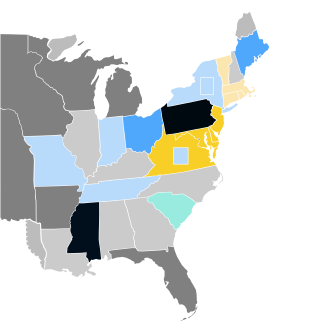
The 1832–33 United States Senate elections were held on various dates in various states. As these U.S. Senate elections were prior to the ratification of the Seventeenth Amendment in 1913, senators were chosen by state legislatures. Senators were elected over a wide range of time throughout 1832 and 1833, and a seat may have been filled months late or remained vacant due to legislative deadlock. In these elections, terms were up for the senators in Class 1.

The 1832–33 United States Senate election in Pennsylvania was held on eleven separate dates from December 1832 to December 1833. On December 7, 1833, Samuel McKean was elected by the Pennsylvania General Assembly to the United States Senate.

A special election was held in Pennsylvania's 8th congressional district on October 13, 1829 to fill two vacancies in Pennsylvania's congressional delegation before the first session of the 21st Congress. The vacancies had been caused by the resignations of Samuel D. Ingham (J) who was chosen as U.S. Treasury Secretary and George Wolf (J) who was elected Governor of Pennsylvania

On November 22, 1831, a special election was held in Pennsylvania's 11th congressional district to fill a vacancy caused by the death of William Ramsey (D) on September 29, 1831.














